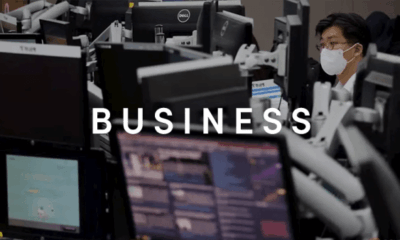Business
U.S. Firms Drive Record €100 Billion in Euro-Denominated Bonds

U.S. companies are increasingly turning to the euro-denominated bond market, with sales reaching a record €100 billion this year. This surge reflects favorable funding conditions in Europe and a growing inclination among issuers and investors to diversify away from the dollar. Major corporations such as Alphabet, Visa, PepsiCo, Fiserv, and Verizon have recently capitalized on this trend.
This offshore fundraising phenomenon, referred to as “reverse Yankees,” has seen a notable increase from just over €78 billion throughout 2023, according to data from LSEG. The shift is seen as beneficial for the euro, especially as the dollar has depreciated by approximately 10 percent this year, partly due to concerns surrounding unpredictable U.S. trade policy. Christine Lagarde, President of the European Central Bank, has called for a “global euro moment,” underscoring the growing significance of the euro in global finance.
Investment Trends Favoring Euro Debt
Matteo Benedetto, EMEA co-head of investment grade syndicate at Morgan Stanley, stated, “There is a wall of currency ready to be deployed into European credit.” He highlighted a broader trend of asset reallocation towards the euro. A recent report by ING points to an increasing preference for euro-denominated debt among global issuers, indicating that this trend may continue, driven by lower borrowing costs and favorable currency dynamics.
Despite this optimism, analysts caution against prematurely declaring a turning point for the dollar’s dominance. Currently, the cost of issuing bonds in euros, when swapped back to dollars, is at least comparable to the costs for U.S. firms issuing in dollars. Benedetto noted that non-financial firms have led the charge in reverse Yankee issuances, raising nearly €50 billion (approximately $59 billion) this year alone, marking a 32 percent increase year-on-year.
Alphabet, which recently achieved a market capitalization of $3 trillion, raised close to €7 billion in May. In the same month, Fiserv secured €2.175 billion, and Verizon raised €2 billion in July through the sale of seven- and twelve-year notes. While representatives from Alphabet, Visa, PepsiCo, and Verizon did not respond to inquiries, Fiserv declined to comment on its bond sale.
Market Dynamics and Investor Interest
U.S. financial institutions have also significantly increased their euro-denominated bond issuance to roughly €35 billion this year, according to LSEG data. Investors, including Zurich-based Vontobel Asset Management, are actively purchasing these euro bond offerings from U.S. companies. Christian Hantel, head of global corporate bonds at Vontobel, emphasized the opportunity for investors to diversify beyond their European core allocations.
The influx of euro-denominated bonds from American firms has raised the U.S. share in traditional debt indices, making it difficult for investors to overlook. The representation of U.S. corporate issuers in the iShares Core Euro Corporate Bond ETF grew to nearly 19 percent by August’s end, up from around 18 percent at the end of 2023. This index is second only to France, according to Morningstar data.
Benedetto noted that the reverse Yankee bond sales have been well-received in the euro market, offering issuers significant size, price efficiency, and flexibility in bond maturity. BNP Paribas and Morgan Stanley played key roles in a €3.3 billion bond sale for Pfizer in May and a €3.5 billion sale for IBM earlier this year, respectively. Baratta, global co-head of investment grade finance at BNP Paribas, observed that U.S. firms can now secure debt maturities of up to 20 years in euros, surpassing the traditional five to twelve-year timeframe.
The rising euro, which has appreciated nearly 14 percent this year to $1.17, further enhances the euro’s attractiveness. Some analysts predict it could rise to $1.20. The euro continues to hold its position as the second-most utilized currency in international debt markets after the dollar, with a 39 percent share, according to ING.
Connor Olvany, a portfolio manager at L&G Asset Management’s European Credit team, emphasized that the shift does not imply a withdrawal from U.S. corporate investments. Instead, it offers investors a chance to diversify their assets from U.S. dollar holdings to euro assets, reflecting a changing landscape in global finance.
-

 Lifestyle3 months ago
Lifestyle3 months agoHumanism Camp Engages 250 Youths in Summer Fest 2025
-

 Sports3 months ago
Sports3 months agoDe Minaur Triumphs at Washington Open After Thrilling Comeback
-

 Business4 months ago
Business4 months agoKenvue Dismisses CEO Thibaut Mongon as Strategic Review Advances
-

 Sports4 months ago
Sports4 months agoTupou and Daugunu Join First Nations Squad for Lions Clash
-

 Top Stories4 months ago
Top Stories4 months agoColombian Senator Miguel Uribe Shows Signs of Recovery After Attack
-

 World4 months ago
World4 months agoASEAN Gears Up for Historic Joint Meeting of Foreign and Economic Ministers
-

 Business4 months ago
Business4 months agoOil Prices Surge Following New EU Sanctions on Russia
-

 Health3 months ago
Health3 months agoNew Study Challenges Assumptions About Aging and Inflammation
-

 Entertainment3 months ago
Entertainment3 months agoDetaşe-Sabah Violin Ensemble Captivates at Gabala Music Festival
-

 Entertainment3 months ago
Entertainment3 months agoBaku Metro Extends Hours for Justin Timberlake Concert
-

 Business4 months ago
Business4 months agoU.S. House Approves Stablecoin Bill, Sends to Trump for Signature
-

 Top Stories4 months ago
Top Stories4 months agoRethinking Singapore’s F&B Regulations Amid Business Closures









